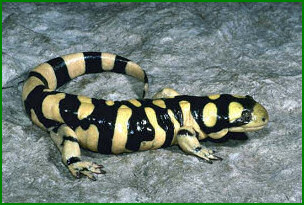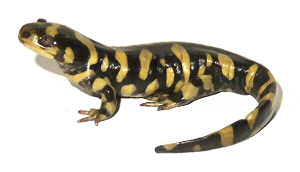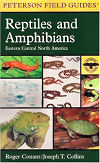
HOME
INTRO
SYMBOLS
ALMANAC
ECONOMY
GEOGRAPHY
STATE MAPS
PEOPLE
GOVERNMENT
FORUM
NEWS
COOL SCHOOLS
STATE QUIZ
STATE LINKS
BOOK STORE
MARKETPLACE
GUESTBOOK
CONTACT US


Tweet
Double click on word for definition.
Kansas State Amphibian

The movement to adopt the Barred Tiger Salamander as an official state amphibian began in an elementary school in Wichita, Kansas. In the spring of 1993, second graders in Alice Potts' class at OK Elementary School were studying animals with backbones. During this period, an idea to promote the Barred Tiger Salamander as the official state amphibian of Kansas was introduced. And why not?
The Barred Tiger Salamander is common throughout the state. It's the largest land-based salamander in the world, sometimes growing to 13 1/2" long. It's beautifully marked and seems to b always smiling!

Kansas State Amphibian: Barred Tiger Salamander
Photograph: © Wayne Van Devender. Used with permission.
To make the Barred Salamander the official state amphibian, the children had to find a legislator that would write a bill, introduce it to the Kansas State Legislature and make sure that the bill was approved. All of the Sedgwick County legislators were contacted and informed of the idea. The legislators were very polite, but responded that it was too late to introduce a bill in the current legislative session. The introduction would have to wait until the next session of the legislature in Januray, 1994.
Summer came and with it, summer vacations. The project was not forgotten and in the autumn of 1993, Alice Potts presented the idea of campaigning for an official Kansas amphibian to other members of the OK Elementary School staff. The idea was a hit and soon the whole school, including teachers, students and parents, was involved. School Principal Judy George was excited and, at her suggestion, the project was made part of the 93-94 School Improvement Process.

Kansas State Capitol
By January 1994, when the Kansas State Legislature was in session again, OK Elementary School was prepared. Because the legislature normally meets for only 90 days each year, they had to work fast. On March 8, as time was winding down, Principal Judy George, second grade Teacher Alice Potts and Interrelated's Rita Rhodes went to Topeka to testify before the Federal and State Affairs Senate Committee. Four students accompanied them; Courtney Glasper; Betsy Hughes; Chris Obando; and Cheri Freund. A few days later, Senate Bill 494, adopting the Barred Tiger Salamander as the official state amphibian of Kansas, was sent to the Senate floor for a vote. It was passed.
Next, the bill was sent to the State House of Representatives for their approval. Here, the bill ran into a little trouble because some Representatives thought that it was frivolous and that there was more important legislation that needed attention. Time was running short... only about two weeks left to get the bill passed in the House!
Senator Mike Harris came to the rescue. He attached the salamander bill to another bill to ensure that the case for the official state amphibian would be heard in the House of Representatives. On March 31, 1994, the Kansas House of Representatives passed a bill that adopted the Barred Tiger Salamander as the official state amphibian of Kansas. The legislation was signed by Governor Joan Finney on April 13, 1994.
About the Barred Tiger Salamander

Kansas State Amphibian: Barred Tiger Salamander
Photograph: © Larry L. Miller. Used with permission.
The Barred Tiger Salamander is the largest terrestrial (lives on land) salamander in the world. Though typically 6-8 1/2 inches, it can grow to a length of 13 1/2 inches. They are also long-lived with estimates that they may live for 20 years. As you can see from the pictures, the salamander is sided with irregular yellow bars that extend from their bellies to the middle of their backs. What's not so obvious is that they have only four toes on their front feet and five toes on their back feet.
Barred Tiger Salamanders can be found throughout most of Kansas. They can live in a variety of environments from forests to desert scrublands. They can be found in forest ponds, in prairie lands and limestone streams. They do like to stay cool and moist and require water to lay their eggs in the spring or fall. Though they are widely distributed and they can grow to be quite large, they are not easy to find. They spend most of the summer and winter in underground burrows, sometimes borrowing the homes of crayfish, or even prairie dogs where it's moist. They are active at night. The best time to find them is during breeding season, which may occur in the spring or in the fall.
When they are hungry, they eat earthworms, large insects, small mice, and smaller amphibians.
Kansas Law
The following information was excerpted from the Kansas General Statutes, Chapter 73, Article 23.
CHAPTER 73. SOLDIERS, SAILORS AND PATRIOTIC EMBLEMS.
ARTICLE 23. STATE AMPHIBIAN.
73-2301. Official amphibian of Kansas. The barred tiger salamander (ambystoma tigrinum mavortium, Baird, 1850) being a strikingly marked species, with robust body, and living in a range from the humid tallgrass prairie of eastern Kansas to the arid high plains at the western border, is hereby designated as the official amphibian of the state of Kansas.
History: L. 1994, ch. 79, § 10; July 1.
Sources...
Revised Statutes Kansas Legislature. 2004. 16 December 2004
OK Elementary School. 2004. 14 December 2004
Great Plains Nature Center. 2004. 18 December 2004
Additional Information
Barred Tiger Salamander: Great Plains Nature Center, Wichita, Kansas.
Caudata Culture: Information for everyone interested in these animals, from beginning petkeepers to professional herpetologists.
Barred Tiger Salamander Factsheet: Texas Parks and Wildlife factsheet.
State amphibians: Complete list of official state amphibians from NETSTATE.COM.
More symbols & emblems: Complete list of official Kansas state symbols from NETSTATE.COM.
Newts and Salamandersby Frank Indiviglio
Salamanders of the United States and Canada: by James W. Petranka. 587 pages. Smithsonian; 1 edition (July 17, 1998) This survey of North American salamanders is the first since the 1940s and presents the most up-to-date research on every species. Beginning with two keys to help the reader identify an animal in the hand, whether it is an adult or a larva ("tadpole"), the book then discusses each species individually.
Newts and Salamanders: Everything About Selection, Care, Nutrition, Diseases, Breeding, and Behavior by Frank Indiviglio. 96 pages. Barron's Educational Series (June 1, 1997) Terrarium enthusiasts will find up-to-date information and full-color photos describing the major native and exotic species of newts and salamanders. The author gives advice on feeding and keeping them in a healthful environment. Topics include creating the various types of habitats, nutrition, reproduction, the treatment of diseases, and sources of food and supplies.
What is an Amphibian? (The Science of Living Things) , by Bobbie Kalman and Jacqueline Langille, 32 pages, Crabtree Publishing Company (2000). Reading level: Ages 9-12. The large, full-color photographs and illustrations that pepper every page of these books will catch the eye of browsers but it is the informative, easy-to-read texts that will hold their interest.
Peterson First Guide to Reptiles and Amphibians , by Robert C. Stebbins, Joseph T. Collins and Roger Conant. Edited by Roger Tory Peterson. 128 pages, Houghton Mifflin Harcourt (April 15, 1999). From mudpuppies to rattlesnakes, this fascinating guide for young nature lovers describes the habits and habitats of these secretive and sometimes bizarre animals, and includes tips on how to catch and care for frogs, snakes, turtles, lizards, salamanders, and toads.

A Field Guide to Reptiles & Amphibians of Eastern & Central North America, by Roger Conant and Joseph T. Collins, 640 pages, Houghton Mifflin Harcourt; Fourth Edition edition (May 15, 1998). This newly designed field guides features detailed descriptions of 595 species and subspecies. The 656 full-color illustrations and 384 drawings show key details for accurate identification. More than 100 color photographs and 333 color photographs and 333 color distribution maps accompany the species descriptions.
Firefly Encyclopedia of Reptiles and Amphibians, edited by Tim Halliday and Kraig Adler, 240 pages, Firefly Books (September 7, 2002). With lush color photographs and lavishly detailed illustrations, this encyclopedia presents a striking abundance of information at a glance. Also noteworthy is the scholarly text, a comprehensive overview of these frequently studied phyla.
Reptiles & Amphibians for Dummies, by Patricia Bartlett, 360 pages, For Dummies; 1st edition (June 1, 2003) This essential guide tells you what you must know before you own a reptile or amphibian, with authoritative advice on everything from proper caging and feeding to health care, socializing, transporting, and more. You'll find out about the different species, normal and abnormal behavior, the basics of breeding, and complying with laws.

